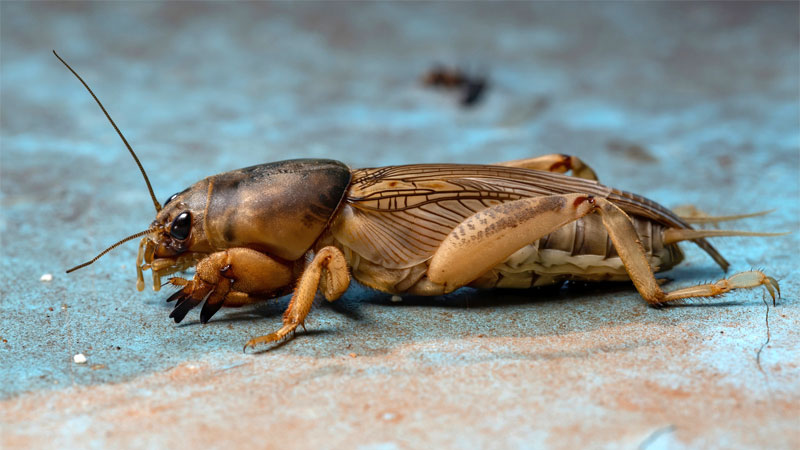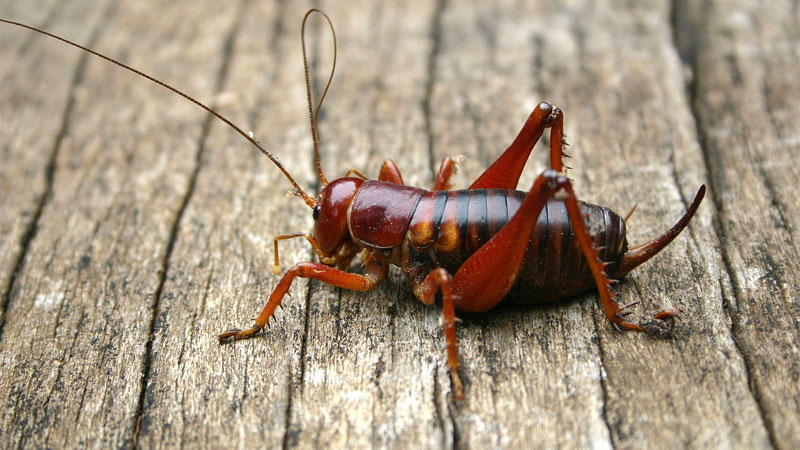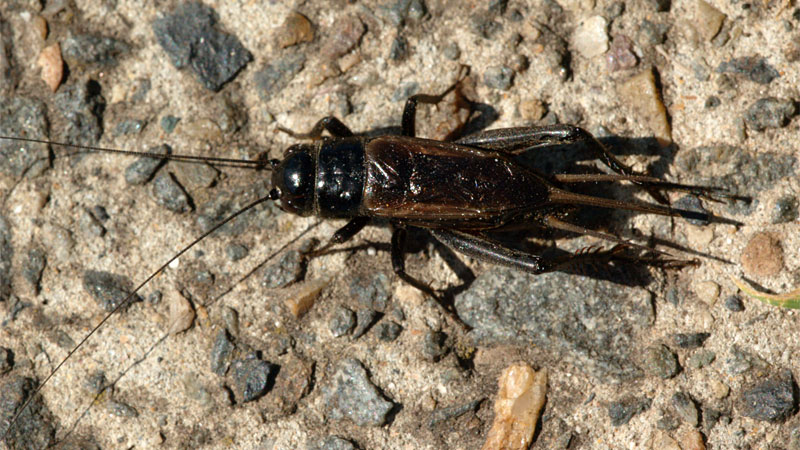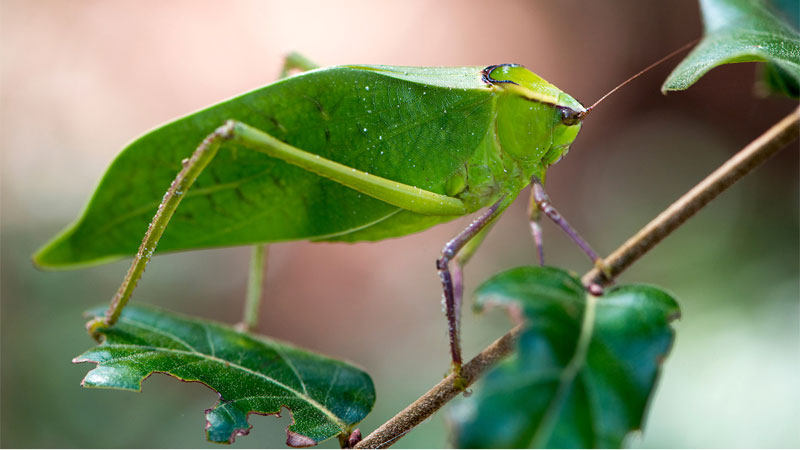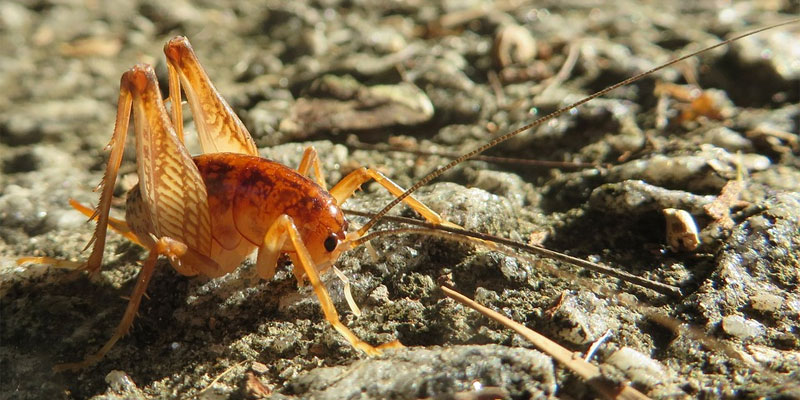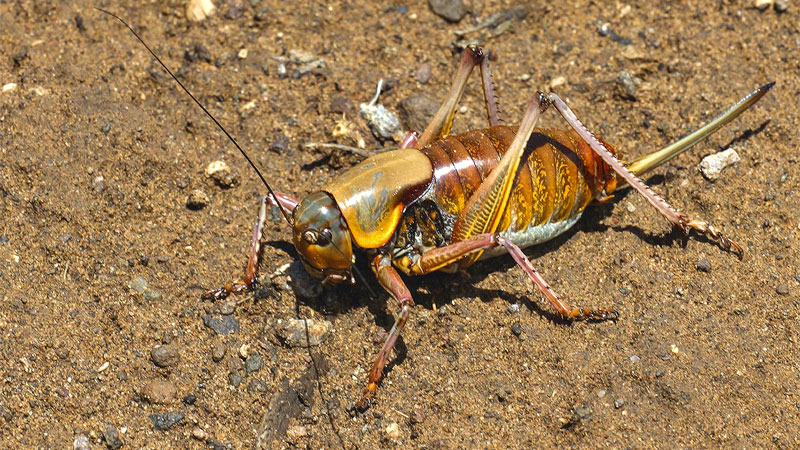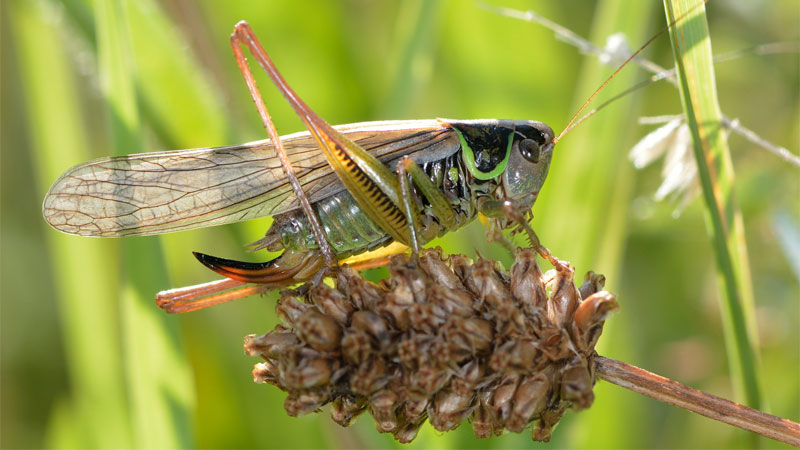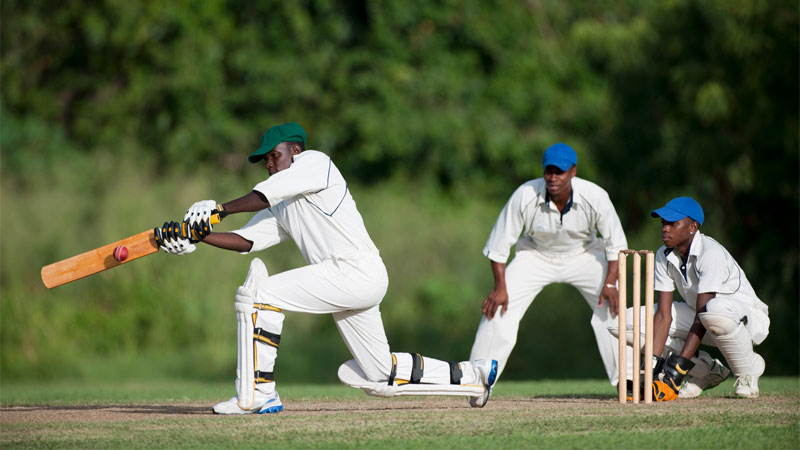Everyone knows the sound of crickets, but few know how varied they can be. Perhaps that’s because the scientific world spends more time letting us listen to crickets than they do telling us about all of the neat differences between species.
So let’s interrupt that familiar sound by looking at 17 different types of crickets and just how crazy these critters can get!
Types of Crickets
#1 – African Cricket, AKA Parktown Prawn (Libanasidus vittatus)
Native to South Africa and nearby areas, this species of king cricket is nearly 2.4 inches long and has peculiar tusks on its mandibles. While considered a pest in homes, they’re quite welcome in gardens where they feast upon moth larvae, slugs, and snails. They also attract a number of insectivore predators.
However, they will also munch on pet food, pet droppings, fallen fruit, carrion, and even wood (although they can’t actually digest the wood). This has led the African Cricket to have quite the duplicitous reputation.
#2 – Australian Field Cricket (Teleogryllus oceanicus)
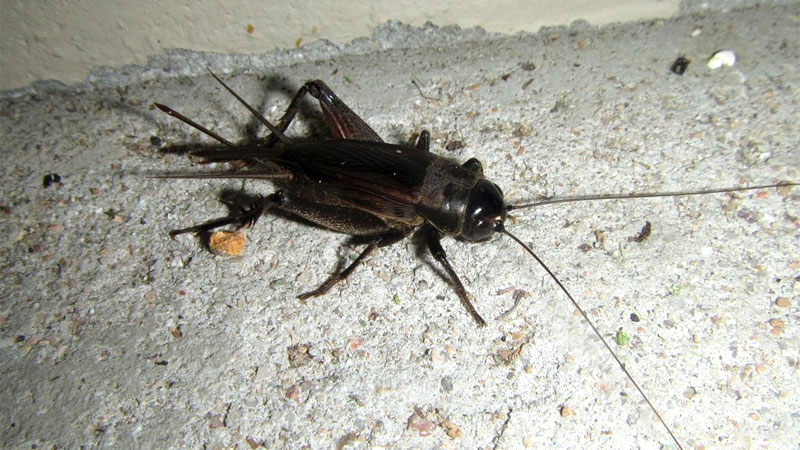
Found throughout the continent of Australia, this cricket species is sometimes also known as the Pacific or oceanic field cricket. It’s a mix of black and dark brown with stripes on the back of its head. At 1.2 to 1.3 inches long, this species tends to group together in large numbers and will dig burrows if they can’t find a crack or hole to hide in.
Oddly enough, these little guys introduced to Hawai’i where the parasitic fly Ormia ochracea began homing in on their chirps. As a result, the species quickly learned to stop chirping when the flies are active and are actually mutating so they can no longer produce sound, which may soon result in the Hawai’ian specimens being reclassified as a new species.
#3 – Black Field Cricket (Teleogryllus commodus)
This species is so closely related to the Australian field cricket that the latter was once thought to be part of the former. However, this type of cricket tends to top out at around 1.2 inches long and has a slightly more restricted range of the Australian mainland and New Zealand.
Incidentally, these particular chirpers make for a great pet. They are among many species that can be trained using odors.
#4 – Bush Crickets, AKA Katydids (Tettigoniidae family)
Consisting of over 8,000 species, these curious critters look more like grasshoppers than crickets. However, they have extremely long antennae that are sometimes bigger than their bodies. They also come in a variety of shapes and sizes, often taking on the appearance of leaves for camouflage.
Unlike true crickets, they lack hind wings, which prevent them from flying. Instead, they use their long forewings to help break falls from great heights.
These crickets got their name from the wing chirps made by a particular species, Pterophylla camellifolia, better known as the true katydid.
#5 – Camel Cricket (Rhaphidophoridae family)
These are visually very different crickets from the ones you’re used to seeing. Sometimes referred to as cave crickets or spider crickets, this type comes in more than 1,100 species. They have brown bodies with a hunched abdomen, long, spider-like legs, and no wings.
These common pests prefer dark, damp locations such as caves or rotting tree hollows but are also known to infest basements. They love munching on plant matter, which includes fabric and cardboard. Even worse, camel crickets will leave a foul odor behind in places they infest. As a result, they’re not very good pets (or guests).
#6 – Carolina Leaf-Roller (Camptonotus carolinensis)
It’s time to throw out everything you know about different kinds of crickets, because the Carolina leaf-roller breaks all the rules! This crazy critter is the only one out of 600 species of raspy crickets to inhabit the US. As with other raspies, it has normal hind legs and can’t jump.
As an opportunistic feeder and nocturnal critter, the leaf-roller will cut into a leaf’s edge, roll it, and use the silk it creates to hold the leaf together in a makeshift shelter. That’s right, this critter can’t jump and makes silk. To top it off, the leaf-roller has almost comically long antennae that it somehow manages to fit completely into the shelter!
#7 – Dune Crickets, AKA Splay-Footed Crickets (Schizodactylidae family)
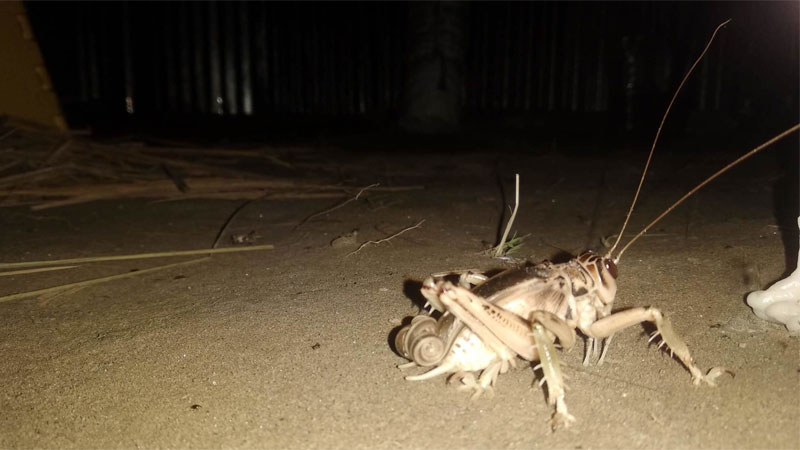
Meet a family of ten living species that visually put all other cricket breeds to shame. Resembling something out of a master woodcarver’s imagination, these little guys really stand out. They’re most commonly found in the deserts of Africa and Asia and have legs that splay out for better traction.
Dune crickets also have antennae that can stretch twice as long as their bodies. They’re also predators, preferring other insects to plants. Fossils of an extinct species date back to the early Cretaceous Period.
#8 – Field cricket (Gryllus spp)
When looking at pictures of different crickets, you’ll find the majority are listed as field crickets. This particular genera is common throughout much of the world, except for Australia and Antarctica. They’re also often mistaken for other cricket types.
These little guys make great pets, great pet food, and are also great for a human snack. While it’s almost impossible to tell them apart if you’re not a biologist, there are at least five known species in the US. Their genitals are literally the only visible variation, making classification extremely difficult.
#9 – House Cricket (Acheta domesticus)
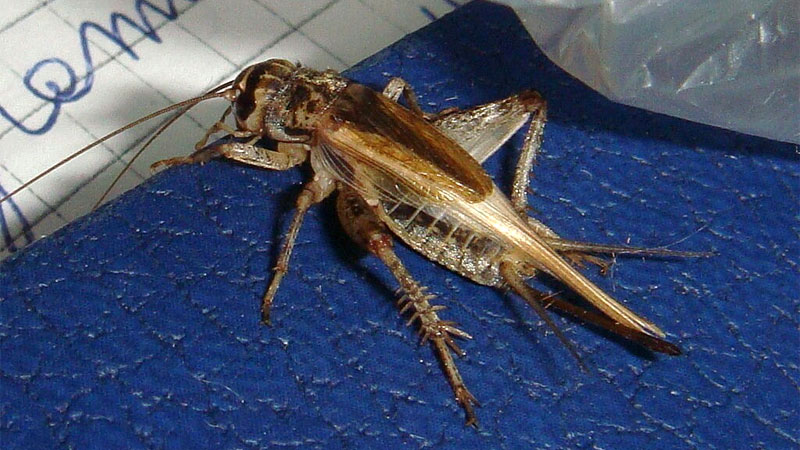
These grey to brown crickets are only around 3/4 inches long and have very strong hind legs. They’re a cosmopolitan species which originated in southeastern Asia and owes its increased range to the unfortunate fact that insect aficionados claim the species has a superior texture and taste.
They’re also one of the most common types of cricket to be kept as pets despite also being one of the louder ones.
#10 – Jerusalem Cricket (Stenopelmatini tribe)
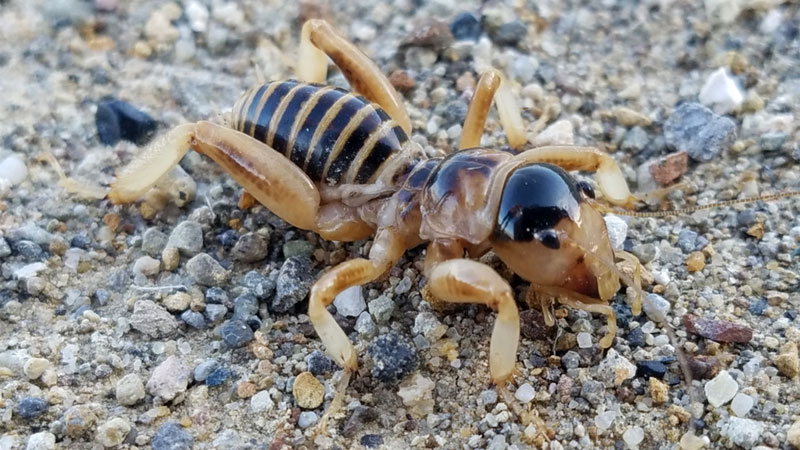
Sometimes referred to as potato bugs (not to be mistaken with other bugs that share the nickname), these bizarre crickets aren’t from Jerusalem at all, but actually hail from North America.
In fact, just about everything involving these insects is a lie: They’re not true crickets, more closely resemble ants, and have no interest in potatoes! What gives?
The tribe consists of 39 confirmed species and 13 debated species across two genera. They’re burrowers and give off an exceptionally foul odor. If the smell isn’t enough, they can hiss at predators.
Instead of chirping (they’re wingless crickets), they beat their abdomens on the ground. Finally, they have really strong mandibles that can deliver a painful bite if you can brave the stench enough to touch one.
#11 – King Cricket (Anostostomatidae family)
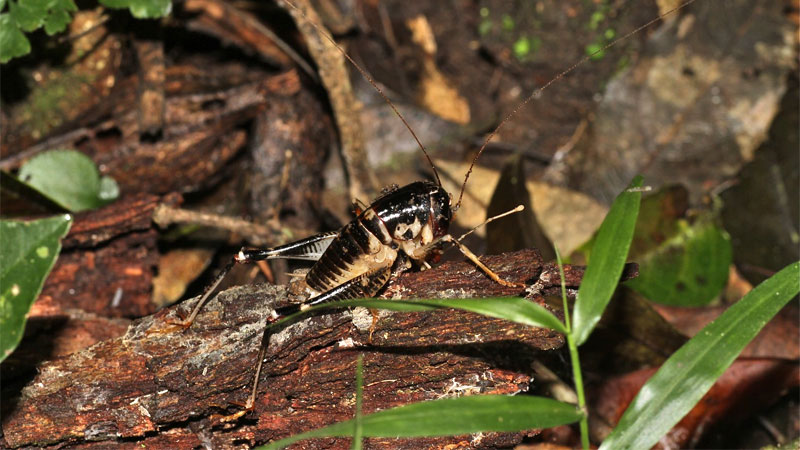
Found throughout various environments in the southern hemisphere, these big crickets come in a variety of large sizes and colors. Some species can fly while others are flightless.
King crickets eat a wide range of foods from fungi to insects. In fact, the Australian king cricket is powerful enough to feast on funnel-web spiders.
#12 – Leaf-Rolling Crickets, AKA Raspy Crickets (Gryllacrididae family)
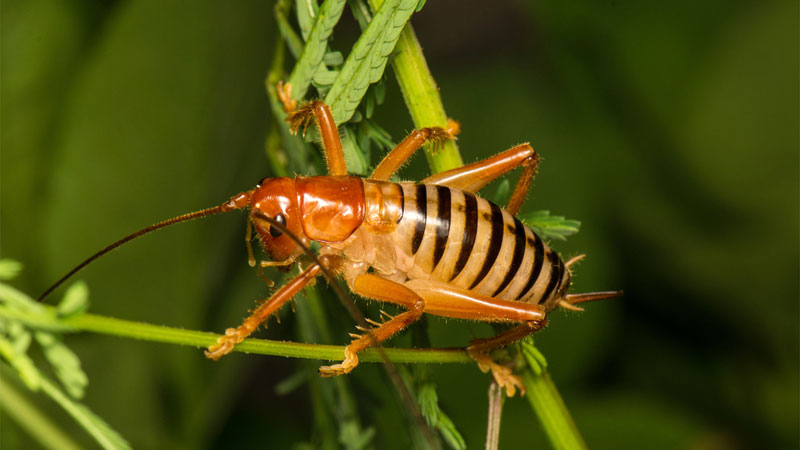
We’ve already mentioned the Carolina leaf-roller, which is the only species in the US. But what about the rest of the raspy cricket family? Well that’s both an easy and difficult question to answer.
The raspy cricket family once included the camel crickets and Jerusalem crickets, which are now separate families. Unfortunately, many resources still lump the three families together.
Generally wingless, these curious crickets won’t jump and are mostly nocturnal. A few will actually dig burrows in dirt, sand, or wood to hide until nightfall. However, most species roll up leaves, sewing them shut using silk like silkworms do.
In fact, due to convergent evolution, their silk is very similar in composition to that of silkworms.
#13 – Mole Cricket (Gryllotalpidae family)
Perhaps the creepiest looking crickets, mole crickets have streamlined, cylindrical bodies covered in fine, dense hairs. Their hind legs are similar to true crickets, but the forelegs look more like the legs of a mammal, being flat with spiky “toes” for digging.
Their beady little eyes are barely visible and they have underdeveloped, functionless wings.
In their native habitats, mole crickets are often celebrated, but they’re a frustrating pest in areas they’ve been introduced. They’re especially annoying to farmers, as their burrowing can dislodge seeds, damage seedlings, and cause the topsoil to dry out.
#14 – Mormon Cricket (Anabrus simplex)
This particular species of shieldbacked katydid doesn’t particularly care about religion, although they hold a religious significance for the Mormons who settled in Utah.
They can be found throughout the western portions of North America and are notorious for forming massive swarms during droughts. These swarms obliterate crops and leave behind crushed bodies and nasty stains.
Mormon crickets are well known for attacking crops in the Salt Lake valley whenever there’s a drought, and local gulls regularly feast upon them.
According to Mormon legends, the crickets swarmed their second crop of food in 1848 and God sent legions of gulls to devour the crickets and save the crops. Later, it was proven that the crops were heavily damaged by more than just the crickets, and the gulls had little effect.
Additionally, this same scenario has played out multiple times since 1848 without posing any religious significance. Despite these facts, the “Miracle of the Gulls” remains a significant event in Mormon teachings.
#15 – Roesel’s Bush Cricket (Roeseliana roeselii)
This species of bush cricket looks very similar to a grasshopper with a shorter abdomen. Their wings are incapable of flight and they tend to be identifiable by the yellow-green spots along their abdomen.
Native to Europe and Russia as far east as the Yenisei River, these inch-long katydids have spread to North America. It’s said that their distinctively long, high-pitched buzzing is designed to mimic electrical wires or Savi’s warbler to mask their presence from predators.
Read Also: 13 Fascinating Grasshopper Facts
#16 – Tree Crickets (Oecanthinae subfamily)
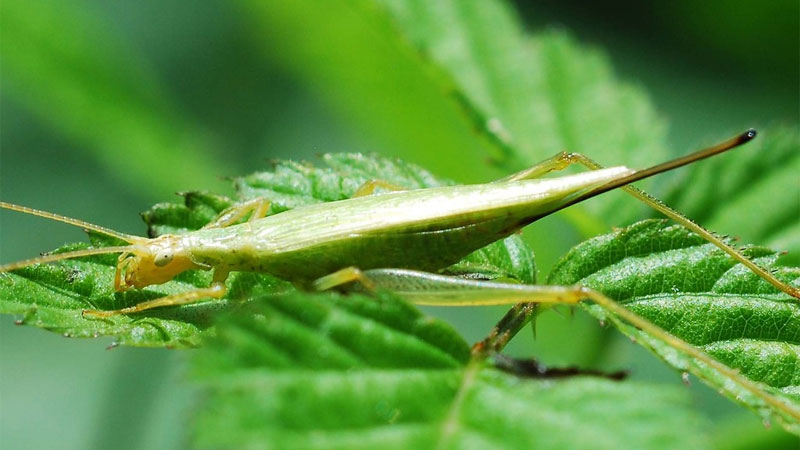
This large group of crickets is quite unusual, with long, thin bodies that taper to a point. They’re skilled fliers and have a cosmopolitan range.
As tree crickets prefer to dwell in trees and shrubs, their body shapes allow them to resemble twigs and furled leaves, complete with coloration matching where each species prefers to live.
#17 – English Cricket (Gamus popularus)
This strange type of non-insect cricket is found throughout the civilized world but is native to England. Commonly called cricketers, one human throws a ball at a wicket, which must be defended by another human with a bat.
It’s believed that there are cricket varieties found in every civilization in the galaxy, much like the phenomenon of Swedish meatballs.
Bonus: 5 Fun Facts
We’ve talked about 16 types of cricket (insect) and one non-insect type. But there are some interesting facts most of the insect crickets have in common. Here are five of them:
- How many different species of crickets are there? Believe it or not, there are over 15,000 known species so far with more being discovered! Roughly 900 species are classified as “true crickets” (Gryllidae family). Around 1,200 species can be found in the US alone.
- While we sometimes want/need to get rid of them, crickets play an important role in maintaining balance in our ecosystem and have additional benefits.
- Throughout history, they’ve been kept as pets, and are often seen as a symbol of good fortune.
- Many types of cricket insect are edible and quite good for you. That’s right, per ounce, crickets have twice as much protein as chicken and 50% more than beef. Fried crickets taste just like potato chips (and can even be seasoned to match popular chip flavors).
- While some species fly, others are strictly ground crickets, and not all chirp. In fact, cricket behavior is about as varied amongst cricket-kind as it is within the human race.
Read Also: 13 Fascinating Grasshopper Facts
- How to Get Rid of Hawks - March 8, 2024
- How to Get Rid of Pill Bugs (Rolly Pollies) - March 1, 2024
- How to Get Rid of Groundhogs (Woodchucks) - February 5, 2024

